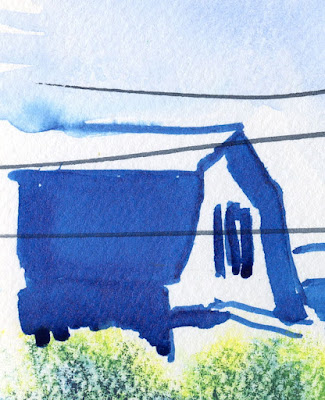 |
| 2/24/22 Faber-Castell Durer watercolor markers and Caran d'Ache Museum Aquarelle pencils in Stillman & Birn Beta sketchbook |
Here’s another experiment with Faber-Castell Albrecht Dürer watercolor markers combined with Caran d’Ache Museum Aquarelle pencils.
I picked out a triad including a garish Middle Purple Pink (125) and Cadmium
Yellow (107) knocked back by a subdued Indanthrene Blue (247).
For the sky, I tried a wet-in-wet technique that I often use with watercolor pencils: After generously wetting the paper, I “licked” ink from the marker tip with a waterbrush and swiped the color onto the wet paper. For the three little trees behind the pink house, I wet the paper with a brush, then quickly tapped the blue and yellow markers directly into the wet; they blended nicely just like watercolors. (Those three trees are probably the only bit about this sketch that I like.) But I have to ask: If a wet-in-wet approach is desired, why not use conventional watercolor paints? I can’t see any advantage to using these markers.
The foreground foliage started similarly to the three background trees – markers applied directly to the wet page. I didn’t like the result at all (see below), so after the paper dried completely, I went over it with a couple of watercolor pencils to regain the texture and activated them lightly. I like this result better (top of post), but not better than watercolor pencils alone.
 |
| The foreground foliage (Durer markers only) before applying colored pencil. |
I’m not really feeling it with these markers; to keep using them, I have to find a way in which the markers uniquely enhance watercolor pencils. However, as far as markers go, I will say one positive thing about these Dürer markers compared to their waterproof sisters, Faber-Castell Pitt Big Brush Artist Pens (which are no longer available but have been reincarnated as a two-headed creature): If you work quickly, the juicy Dürer watercolor markers remain wet long enough that the typical marker-y streak marks mostly disappear. This is almost impossible to do with Pitt ink, which must dry faster. The blue swatch below is a watercolor marker that I swiped repeatedly and quickly. Below it is a swatch of a Pitt Big Brush pen, which leaves behind more telltale streaks.
 |
| The Durer watercolor marker streaks disappear better than Pitt Artist Pens. |
It’s easiest to swipe quickly in small areas, of course. In the details from two sketches below, I swiped solid areas of color on the rooftops and was pleased that no marker-y marks were visible.
 |
| The solid rooftop areas here and below show no marker streaks. |
I didn’t need to rewet the color to blend out the marks as I had to do in the first sketch I did with these markers a few weeks ago (detail below). I think I was swiping more slowly that time, so the ink had dried more.
 |
| I didn't work fast enough in this sketch, so more of the marker streaks are visible. |
The upshot is that if I wanted to make areas of flat, solid color, I would choose the Dürers over the Pitts. I used to use a dark gray Pitt marker routinely as a grisaille and for large areas of shadow because it was faster than applying the same amount of gray with a colored pencil. However, in that case, it was important for the grisaille marker to be waterproof so that the gray wouldn’t muddy the colored pencil color when I activated the latter. Once again, I’m not seeing an advantage to using a watercolor marker for this application, either.
Hmmm. Why am I using these Dürers again? At least I’m having fun experimenting and mixing them up with watercolor pencils, but maybe these markers need to be mixed with something else. Stay tuned.
 |
| Not feeling it yet with these markers but having fun! |

It is always fun to see your experiments and read a bit about your thinking as you worked.
ReplyDeleteGlad you enjoy my experiments and process notes because I tend to do a lot of thinking aloud here! ;-)
Delete